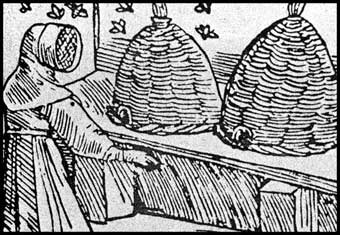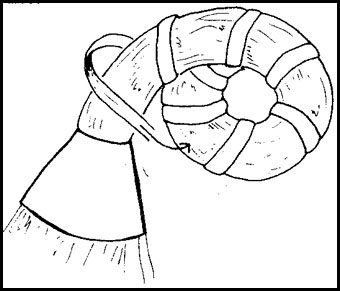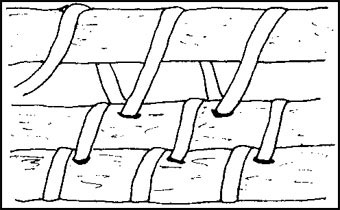Thursday, May 9, 2013
A Bee Skep
Spring gardening books and magazines are arriving this time of year. I thought it appropriate to research the bee skep (since so many photos from colonial and early gardens include at least one). While I was researching, I stumbled across directions to make your own bee skep. Something I will add to my list of projects. My post on bee skeps has a brief history along with easy to follow instructions for making your own bee skep to add authenticity to your early garden. Enjoy!
www.EarlyAmericanHome.net
www.Facebook.com/EarlyAmericanHome
How to Make a Bee Skep
Bee SkepMake a Bee Skep for Your Garden |  |

Honey had myriad uses in colonial America: hams were cured and fruits were preserved in honey; and rinsings from honeycombs were used to make mead (an ancient fermented honey drink). Beeswax was almost as important a product of the skep as honey -- it was used to waterproof leather, to smooth thread for sewing, to bind wounds, as a precious ingredient in candles, and even as a type of early chewing gum.
The relationship between beekeeping and the herb garden is centuries old. Many herbs have a special attraction for bees and, since the insects pollinate the plants, the two work in unison. Lemon balm (its name is derived from the Greek word for “bee”) has long been a neighbor of the bee skep. Early beekeepers rubbed the insides of their skeps with it to attract bees, or mixed balm with honey to line the insides of skeps. Bee balm thyme and borage also attract honeybees.
In 1838, the Farmer's Guide reported that "Of all the substances of which hives are made . . . straw has been the most generally preferred." Straw beehives had been used for centuries by the time of this statement, and it is the dome-topped straw skep that is usually associated with early-American beekeeping. They were made in a variety of sizes. In the middle 1800's, a skepmaker named Wildman was weaving hives "seven inches in height and ten in width. The sides are upright so that the top and bottom are of the same diameter. A hive holds nearly a peck!''' Wildman's small skeps were dwarfed by surviving skeps from Pennsylvania that are two feet tall and a foot across. Some were two-piece; the bottom skep was the larger, with a small hole in its dome, and a smaller skep sat atop it. The queen was kept from the top skep with an excluder -- a physical barrier - that blocked her entrance but allowed the smaller drones to pass through. The drones would not remain, but only deposit honey, so the honey could be removed without killing the bees.
Bees entered and left the skeps by one of several means. Some had holes cut into the straw near the bottom as large as a single coil was thick. Others had no holes; they had to be lifted off the ground slightly and placed on boards to provide access for the bees through the open bottom. Still others had oak splints (thick pieces of oak, split out of a sapling or a branch) sewn to the base through drilled holes. Skeps sometimes had straw handles on top.

Straw skeps had several disadvantages that caused them to be replaced by wooden hive boxes. First, the bees had to be killed to harvest the honey (The two-tiered straw hive alleviated this problem to some extent). If a beekeeper's winter hive died, he would have to find another swarm to start all over again the following summer. Second, the bees attached their comb to the walls of the skep. In some cases two oak rods were pushed through the skep walls so that they crossed inside about halfway up to provide a place for the bees to anchor the comb, but it still ended up stuck to the skep wall.
That is not to say, however, that a modern gardener may not use one of several reproduction skeps to add an authentic touch to a herb garden. Skeps are easy to create with materials gathered from the roadside, or purchased from a local farmer.
An authority on creating skeps, Rolla Chandler once talked about skep-making at a crafts festival in Waterford, Virginia. "I have used all sorts of grasses," he said, ”but I like rye straw best because the stalks are very long. You have to get the rye before the farmer threshes it; after it is threshed the grass is broken into short pieces and is worthless."
If you can find a local farmer who grows wheat, oats, rye, or barley, make arrangements to buy some of it before threshing begins. Otherwise, look for patches of tall grass in the wild. There is no rule of thumb as to how much grass is needed for one skep - that depends on the size of the skep and the diameter of the coils - but a bushel basket of grass should be enough to make a medium-sized skep. Small coils use less grass, but a skep of tiny coils takes longer to weave. A weaving material, called a binder, is also necessary to hold the coils together. Mr. Chandler uses everyday twine; split reed like that used for chair caning works just as well.
The only tools you need are a spray bottle full of water, scissors, a bucket of water if split reed is the binder choice, and a needle. Mr. Chandler’s needle was the blade from a letter opener, dull, with a hole in the nether end through which to thread the binder. If split reed is used for sewing, all you may need is an awl to open the space for the stiff reed to be poked through the coils, and no needle will be required. A funnel-like device is the final tool, through which the straw is pushed to shape the coils. A short section of horn is perfect, as is a hollow bone or anything else of that shape. It must be sturdy, for it will take a good deal of abuse. The small end determines the diameter of the coil. A one-inch coil is a good size, but there is no hard and fast rule.


If you want your skep to have a handle, a loop of straw should be sewn on at this point.
STEP THREE: Skeps are generally dome-topped, so this must be taken into consideration from the very beginning. As the circle widens, make sure it takes on the: shape of a shallow bowl. When this bowl has reached the diameter planned for the finished skep, start coiling the sides straight down.
STEP FOUR: Eventually, the end of this first handful of straw will come, and as it does, simply trim the heads off more straw and poke it into the horn. Continue weaving around the circle, keeping the length of the stitches uniform. When the binder runs out, tie on a new one and, if you are using a needle, thread it through the hole and start looping and stitching as before.

Source: Adapted from an article by Ron Pilling
Found at www.colonialsense.com
Subscribe to:
Comments (Atom)